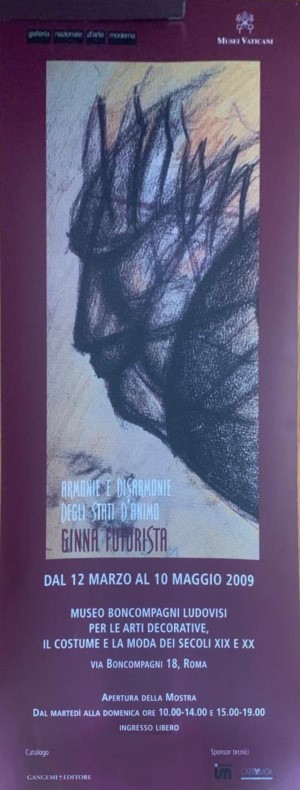Harmonies and disharmonies of the state of mind. Futurist Ginna
12 March – 10 May 2009 – Museo Boncompagni Ludovisi, for decorative arts, costume and fashion of the 19th and 20th centuries (Rome)
22 June – 22 September 2009 -Palazzo Pitti, Andito degli Angioli (Florence)

To mark the centenary of the birth of Futurism, the Galleria Nazionale d’Arte Moderna and the Vatican Museums presented, from 12 March to 10 May 2009, the anthological exhibition ‘Harmonies and disharmonies of moods. Ginna futurista” dedicated to Arnaldo Ginanni Corradini (Ravenna 1890 – Rome 1982) curated by Micol Forti, Mariastella Margozzi and Lucia Collarile.
The same exhibition was subsequently replicated in Florence, from 22 June to 22 September 2009, at the Palazzo Pitti, Andito degli Angioli.
Together with his brother, Bruno Corra, Ginna (their pseudonyms were assigned to them by Giacomo Balla) was one of the most eclectic and fascinating figures of the early 20th century. His philosophical, spiritualist and esoteric interests pushed him towards the experimentation of new linguistic horizons that were to affect the art of painting. His first abstract work Nevrastenia is from 1908, his first film at the movie theatre, on the topic of applied arts, literature, theatre and music, is from 1916 and was called Vita futurista,. This approach was only partly appreciated and understood by the ‘orthodox’ Futurists, but will find Marinetti and Boccioni to be authentic and interesting interlocutors.
Florence, where Ginna lived in 1914, was to become the cultural environment in which most of his productive and authentic period matured, both in artistic and cinematographic content and in respect to the fertile theoretical and literary activity, which gave life, always in partnership with his brother, to numerous periodicals, including ‘L’Italia futurista’ and the publishing series. The exhibit therefore aims to reconstruct the complex personality of Arnaldo Ginna, from his writings to his cinematographic and theatrical experiments, to his rich and multifaceted artistic world, at first figurative, then visionary and abstract, which is connected, in various ways, to so much of European artistic culture, anticipating the many aspects of the surrealist time period. To this end, the exhibition presented works from the 1910s through to the late 1930s and then, in the 1960s, proceeded to document the revival of Futurist themes coinciding with the renewed critical interest in the Italian avant-garde movement. The catalogue published by Gangemi Editore is presented by Maria Vittoria Marini Clarelli, Superintendent of the National Gallery of Modern Art, and Prof. Antonio Paolucci, Director of the Vatican Museums, with contributions by Mario Verdone on cinema, Lucia Collarile on the artist’s various activities, Micol Forti on theoretical writings, Mariastella Margozzi on painting, Giorgio Patrizi on relations with the avant-garde, and Daniela Carmosino on prose works in relation to the cultural context of the early 20th century.
Fact sheets and bibliography edited by Francesca Boschetti.
(from Press Release)

